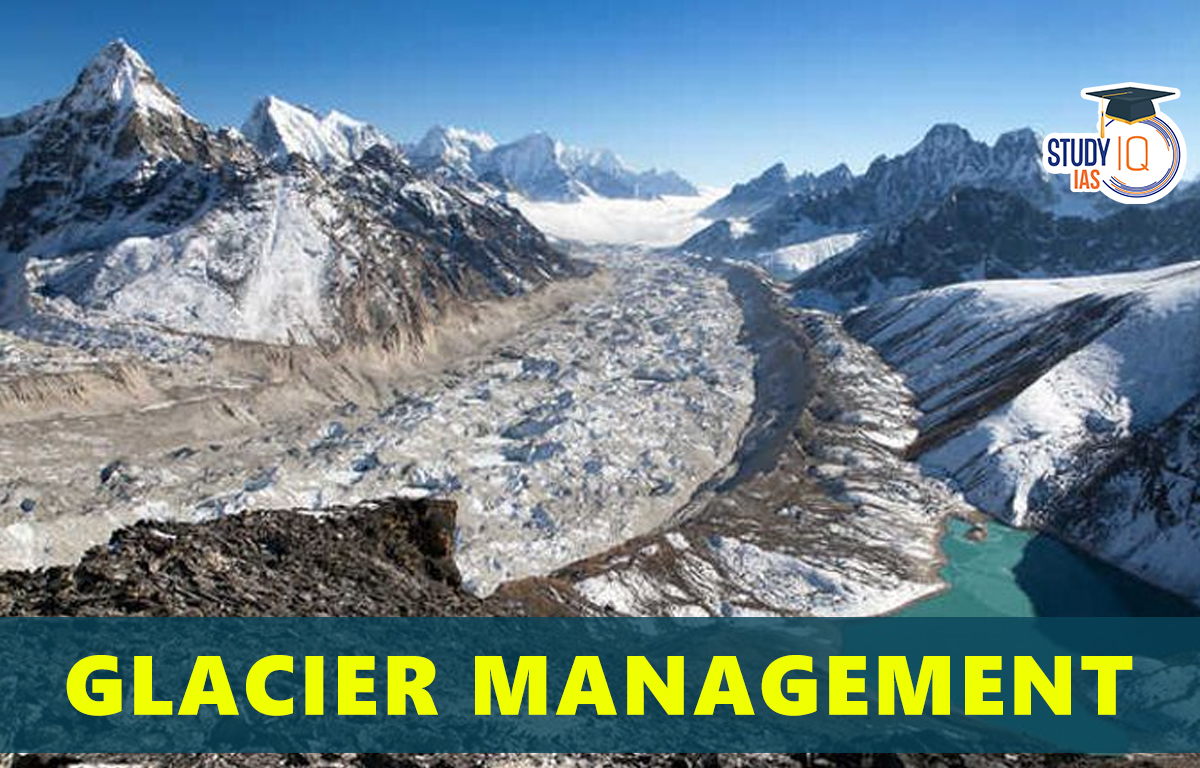Table of Contents
Context: Parliament’s Standing Committee on Water Resources has recommended setting up an apex body for glacier management in the country.
Decoding the Glacier Management News
- Currently, there are different ministries/departments/institutions dealing with hydro-meteorological and hydro-geological hazards of Himalayan glaciers.
- Geological Survey of India carries out surveys and maintains inventory of Himalayan glaciers.
- Matters related to climate change are handled by Ministry of Environment, Forest and Climate Change.
- Research on glaciers is carried out by Department of Science & Technology.
- Studies have been conducted on Himalayan cryosphere by National Centre for Polar and Ocean Research.
- Need for glacier management body:
- Glaciers play a strategic role as a vital national resource in ensuring water security. Hence there is a need to carry out new strategies for combating the challenges posed by climate change and global warming in the glacier management.
- The dedicated body will be responsible for studying, monitoring and providing early warning response to reduce the potential glacier related risks.
- It will coordinate the activities of all the departments/agencies involved in monitoring and research work of Himalayan glaciers.
Cryosphere
- Cryosphere is an all-encompassing term that refers to that part of the Earth’s surface where water is in solid form, including sea ice, frozen lake, frozen river, snow cover, glaciers, polar ice caps, ice sheets, and permafrost.
What are Glaciers?
- A glacier is a large accumulation of ice and snow that slowly moves over land. At lower temperatures, snow accumulates due to low melting. The surplus accumulated snow begins to move in form of glaciers.
- Categorization:
- Alpine glaciers: These glaciers form at high elevation, especially mountains, and flow downwards through steep valleys due to gravity. They are responsible for shaping the valleys.
- Continental glaciers: Also known as ice sheets, they form near Polar Regions and grow into massive size. Their movement is mainly due to their own weight.

- Formation
- Glaciers begin to form when snow remains in the same place year-round, where enough accumulation takes place to transform into ice.
- As more snow gets added in each cycle, previous layers get compressed to recrystalise and harden. Increase in size of snow crystals reduces air pockets, resulting in dense mass of ice.
- Location areas: Glaciers are usually found in regions experiencing high snowfall in winter and low temperatures in summer. This usually occurs in high latitude areas.
- Glaciers can also form near equatorial areas but higher elevations are required for needed snowfall and lower temperatures.
- Majority of glaciers are found near the poles, but glaciers exist on all the world’s continents, including Africa and Oceania (Australia).

Importance of Glaciers
- Source of freshwater: Glaciers hold three fourth of the world’s freshwater supply. Water from glaciers sustains large population across the globe.
- Increase albedo: Glacial regions reflect sunrays, thereby reducing temperatures of cryosphere. This prevents ice from melting.
- Hydropower generation: Freshwater from glaciers is responsible for giving rise to rapidly flowing rivers that can be harnessed to generate hydropower.
- Irrigation: Water from glaciers has been used to irrigate crops in high elevation regions of the world, especially in Ladakh.
- Sea water rise: The key to keep sea levels constant is by preventing melting of glacial ice. Melting of glaciers will result in sea level rise, causing floods.
Threats faced by Glaciers
- Global warming: Global warming is increasing the global temperatures, thereby reducing the ability of snow to accumulate and form ice. Ocean warming is also melting the polar glaciers.
- Carbon Pollution: Pollutants such as black carbon can accumulate over snow cover and increase the temperature of the snow, causing it to melt.
- Climate change: Climate change has affected precipitation cycle across the globe. In absence of precipitation in form of snow, glaciers tend to reduce in size.
Important Glaciers in India
- Siachen glacier: Located near Karakoram rage. It feeds the Nubra River, which ultimately joins Indus.
- Gangotri glacier: Located in Garhwal Himalayas, the glacier is the source of Bhagirathi River, which is the mother stream of the Ganges.
- Zemu glacier: Located near Kanchenjunga Mountain. It feeds the Teesta River.
- Milam glacier: It is located in Kumaon Himalayas. It feeds the Goriganga, which is a tributary of Kali River.
- Bara Shigri glacier: It is located in Pir Panjal Range. It feeds the Chandra River, which is one part of Chandrabhaga River (Chenab).
- Biafo Gyang glacier: Located in Karakoram Range of Gilgit-Baltistan, this glacier gives rise to Shigar River, which is a tributary of Indus.
- Pindari glacier: It is south of Nanda Devi Peak. It feeds the Pindar River, which ultimately joins the Ganges.
- Machoi glacier: Located in Ladakh, it is a source for rivers such as Sind and Dras, which flow into the Indus.
Glaciers in News
- Thwaites glacier (Doomsday glacier): Antarctica
- Chorabari glacier: Mandakini river basin, Uttarakhand
- Lambert glacier: Antarctica
- Vatnajökull Glacier: Iceland
- Mendenhall glacier: Alaska


 Accredited Social Health Activists (ASHA...
Accredited Social Health Activists (ASHA...
 World’s 1st Unique Q-Shield Platform a...
World’s 1st Unique Q-Shield Platform a...
 IB ACIO Recruitment Notification 2025 Ex...
IB ACIO Recruitment Notification 2025 Ex...





















